Original URL: https://www.theregister.com/2007/11/03/darpa_uc_blog/
Living with robots: The $3.5m DARPA Urban Challenge
The race is on
Posted in Science, 3rd November 2007 12:23 GMT
Diary of a human Well, here I am at the crack of dawn getting ready for DARPA's Urban Challenge - the $3.5m robotic race of the century.
5:12 a.m.The hard-working hacks, if you will, were up at 4 in the morning for this shindig. DARPA decided to torture us with a 4:30 a.m registration and 5 a.m media briefing. Only, as it turns out, DARPA decided to move all this back by an hour but only told a few people. (Or I missed the e-mail).
In either case, this place is already abuzz with the sound of generators and people grumbling about the lack of coffee. In about two hours, the DARPA 11 will head toward the racing field. Then, each team will have to put its robotic vehicle through a six hour, 60 mile test here at a retired Air Force base in Victorville - a relatively crap town an hour outside of Los Angeles.
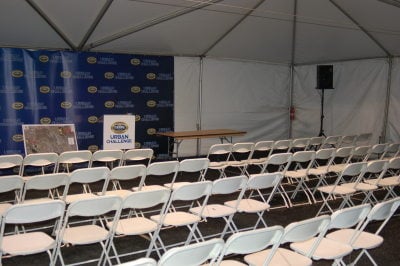
Look, boss. I'm the first one here
Two years ago, Stanford University won the DARPA Grand Challenge by sending a robotic Volkswagen across about a 150-mile desert course. This time, however, Stanford the 10 others have to prove their metal and mettle on an urban course. The vehicles need to park, make turns and merge with traffic all without human aid. All told, they'll be replicating something akin to a California Driver's License test.
The winner of this event takes $2m, while the runners up take $1m and $500,000.
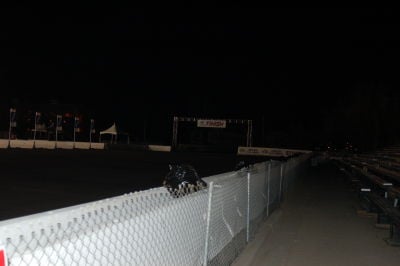
God willing, something will go through this later
Incidentally, I'd like to congratulate what appeared to be Team Princeton University for their beer collection seen through the window at the Ho-Jo. I suspect the lack of wireless bandwidth was the result of a made bittorrent run.
6:00 a.m. Well, very little has happened since the last update other than the other journos showing up. A very kind DARPA representative did refuse me the coffee being served in the official participants' tent because I didn't have a meal ticket. Where's the humanity at this hour? Didn't my tax dollars pay for that coffee?
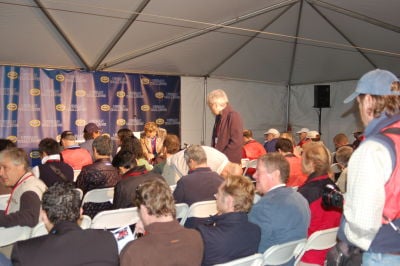
The other hacks arrive
No matter, I went through the exit and got caffeinated. Thanks, Uncle Sam.
The press conference is about to begin. I can hardly wait.
6:15 a.m. So, the DARPA program manager Norman Whitaker led the press briefing. For those of you who don't know, DARPA is the Defense Advanced Research Projects Agency, which is more or less the serious tech R&D arm of the US Defense Department.
Whitaker made a couple of important points that I should highlight. For one, today marks the first time these robot vehicles will be on the course together. Thirty-five teams were invited to a week of tests and only 11 passed DARPA's cut. All of the test runs, however, were done one vehicle at a time.
"They have not interacted at all so far," Whitaker said today. "So, if anyone tells you they know what will happen, they are lying."
Also, 9 of the 11 teams come from universities, while two are private entries. Still, even some of the university teams - Stanford and Carnegie Mellon come to mind - enjoy huge financial backing from DARPA and sponsors such as Google, VW, Intel and Red Bull.
(There are a ton of videos from the test week here.)
You could tell the hour got to Whitaker a bit as he described just how autonomous these machines really are.
"These are vehicles that are full self-contained," he said. "You put them on the starting line and push the button.
"There is no animal or midget inside that is controlling it."
Take note of the midget supply, Tom.
Rather comically, DARPA will not even know if there's a real winner after the race ends today. It will be issuing tickets to vehicles that exceed set speed limits in places, for making illegal turns and the like. After all is said and done, DARPA will measure in infractions against the time it took a vehicle to complete the course and use a mysterious, subjective formula to tap a victor.
"We are looking for the best systems not necessarily the fastest systems," Whitaker said.
I pity the poor stunt drivers cruising around the course with these robots. Some of these bad boys are huge and hardly predictable.
On a historical note, DARPA opted for this type of event after major military contractors failed to deliver much in the way of robotic land vehicles. The government would like to see one-third of military vehicles operate unmanned by 2015. So, it has turned to students, enthusiasts and hungry companies to get the job done.
7:38 a.m. What event of this ilk would be complete without Apple co-founder and professional man child Steve Wozniak.
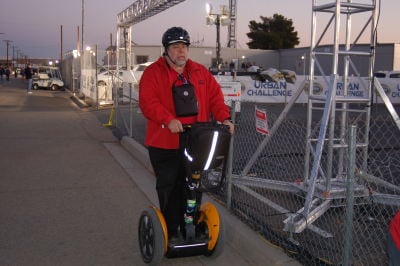
SegWoz
This man will do anything to be seen on a Segway.
7:45 a.m. They've just released the stunt drivers on to the track and pumped out the national anthem. I'm not sure how patriotic the robots are.
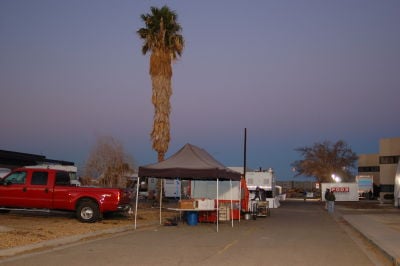
Palm Top
Hundreds of spectators have started streaming into this site - a barren airport/base in the middle of the desert.
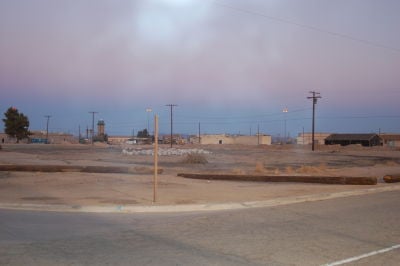
Desert Run
Er, DARPA has asked everyone here to turn off their cell phones because they may or may not effect the bots. Yeah, right.
Just learned that DARPA spent an unreal $21m preparing this site for the race. Frankly, that seems like a ridiculous total, especially given the lack of coffee.
I'm heading off to cover the race start.
9:05 a.m.
All 11 teams got away successfully and have performed well throughout the first hour of the course.
Seeing these vehicles live proves remarkable even for a cynic like me. Some of the vehicles have been tearing down the road and negotiating sharp turns with ease. They've also met head-to-head on the track and passed the tests.
Even more, the cars know when they're able to pass another car. They also know how to advance in order at a four-way stop with indicators on and all.
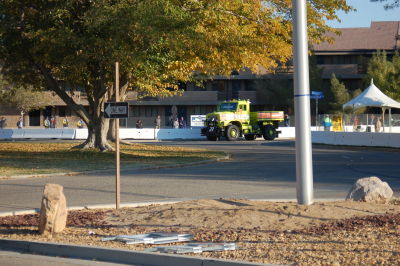
Giant TerraMax from afar
I shocked at how accepting the observers are of the technology. The massive TerraMax system has come ripping by corners a couple of times with only a fence and a wee barricade separating it from the people yet no one even seems to flinch.
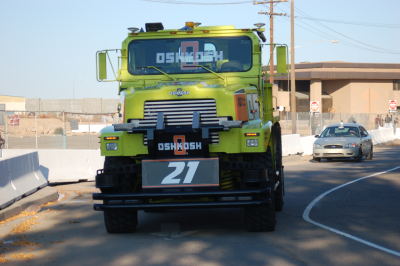
It's coming right for us
There have been a couple moments when the cars struggled with a lane change and started heading toward barriers. But all of the vehicles so far have managed to assess the situation after some time and continue moving.
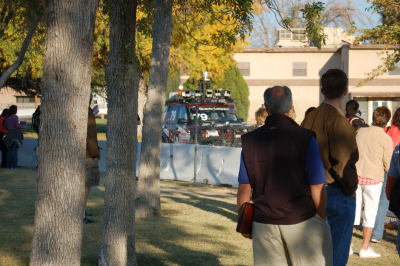
MIT vs. Man
Gear heads out there might be interested to know that the MIT team has a full on server cluster inside its machine. It requires a massive air conditioning unit to keep the hardware cool.
9:35 a.m. About 15 minutes after the last post, some of the vehicles started to struggle. One went off road. TerraMax almost took out a building pillar.
And now we're hearing that three of the vehicles have been booted from the race. Team AnnieWay from Germany is done. We're waiting to hear on the other two.
9:44 Ouch. TerraMax was one of the booted teams. It's the crowd favorite and the most unique looking vehicle in this year's competition. It's also DARPA's favorite, since OshKosh - the maker's of the vehicle - have used a military rig for their design. A larger version of TerraMax was also one of five to complete the 2005 race. Disappointment all around.
The Honeywell/IVS bot is out as well.
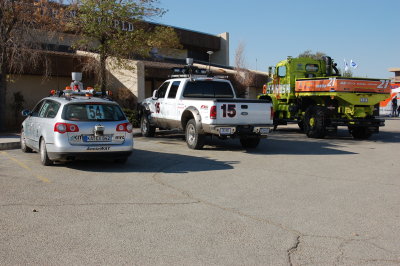
The pain of defeat
11:12 a.m. Five vehicles have been kicked off the course now, and six have all completed mission one. TeamUCF and CarOLO - another German team - are the ones sent off.
Now let's have a closer look at some of the remaining vehicles in action.
11:22
I've been out to a number of the viewing points provided for the media. DARPA lets us peek in on four-way intersections with stops, straightaways and some other choice locales.
One striking thing is the out of nowhere trouble the more sophisticated cars can have on easier parts of the course.
Here's the Cornell vehicle, which got stuck for no apparent reason.
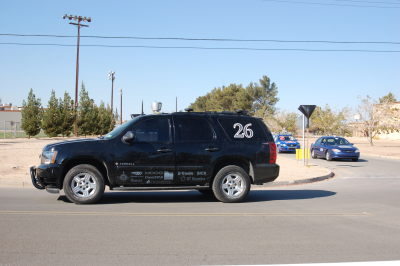
Cornell paused
It would just keep stopping and starting, moving only an inch or two at a time. This went on for about 15 minutes before DARPA allowed team members to drive onto the course and reset the vehicle. I'm confused as to why TerraMax was not afforded the same courtesy.
Stanford's vehicle Junior - in the second position here with manned vehicles all around it - had to wait patiently while the issues with Team Cornell were taken care of.
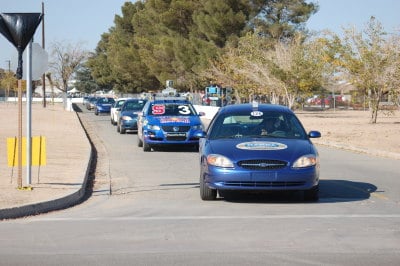
Cornell holds back Stanford
Junior just kept its indicator on like a good driver until it got its turn.
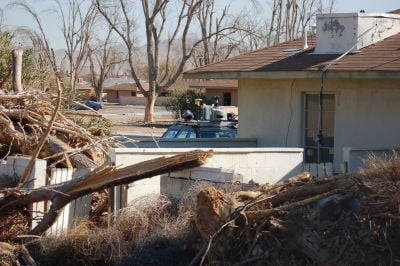
House Ouch
Meanwhile, Team UCF got stuck after almost running into the side of a house here on the retired base. The military uses these crashed out pads for training.
11:51 One of the commenters below made note of DARPA's mind-bending $21m price tag for fixing up this event site.
The reporter next to me remarked, "I've seen county fairs that were better prepared and more impressive than this." And he's right. There's not even a funnel cake booth here.
What's also amusing is all the DARPA propaganda that gets repeated over and over again. Director Anthony Tether receives credit for "bringing his dream to fruition" and personally guiding this stunning event.
Seriously though, and I don't say this lightly, I've never met a single person with anything positive to say about Tether. Most people give Carnegie Mellon prof Red Whittaker credit for pushing this concept forward. They also say Tether gets obsessed with minor details and constantly steps on peoples' toes. Even those inside of DARPA tell me he is "unbearable," while another reporter described him as "a little Stalin."
But, if you believe the hype, Tether is the world's leading robot expert.
And now to more trouble.
12:25 Boo-yah! It had to happen. Robots have collided. MIT and Cornell have crashed. You can't count on those high-priced East Coast schools.
The vehicles rubbed front bumpers before the safety drivers behind them could stop them with their remote shutoff devices. Now they're parked, and the teams are going over the systems to see if they can go back into the field. If the front sensors have been damaged, they'll struggle to return.
Check that. Just after I finished the last sentence, Cornell set out again. MIT is still running checks.
In all honesty, these eventful moments are welcomed by the observers. This thing is all about waiting and watching cars go around and around the course.
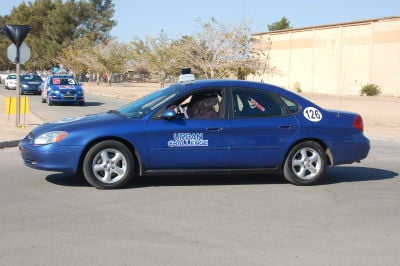
Stunt Man Waiting
And, just after I finished the last sentence, MIT started up again as well.
2:45 p.m. Well after a whole lot of very little, three vehicles made it to the finish line. Stanford once again beat out Carnegie Mellon, and Virginia Tech came next.
Unlike the previous races, however, this was not just a contest based on speed. So, we won't know the real winner until DARPA has used its secret formula that combines speed points with deductions for traffic penalties. The organization will probably announce the finalist tomorrow.
Meanwhile, three vehicles continue on the course.
Sunday 9:03 a.m. Sorry for the delay. I lost all access to a network connection. Ultimately six teams finished the race with Cornell, MIT and a team from University of Pennsylvania coming in later.
The winner will be announced shortly.®
Bootnote
You'll be able to watch the event live here.